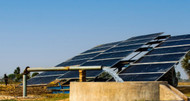SOLAR-POWERED WELL PUMPS VS. GRAVITY-FED WATER SYSTEMS: WHICH IS BEST FOR OFF-GRID LIVING?
18th Jun 2025
Living off-grid means finding self-sufficient ways to meet basic needs, and water access is at the heart of it all. Two popular options for off-grid water supply are solar-powered well pumps and gravity-fed water systems. Both offer unique advantages and challenges, depending on your location, terrain, and lifestyle.

Solar-powered well pumps use energy captured from solar panels to draw water from underground sources. These systems can operate on either direct current (DC) or alternating current (AC). DC pumps are generally more efficient and simpler to install, often running directly off solar panels without needing an inverter. AC pumps tend to be more powerful and better suited for deep wells or higher volume needs, but they typically require a more complex setup with batteries and an inverter, making them more costly and maintenance-intensive.
Gravity-fed water systems rely on elevation to move water. Water is stored in a tank placed above the point of use—usually on a hill, a platform, or a raised structure—so that gravity can create enough pressure to supply a home or garden. These systems are incredibly low-maintenance and don’t require any electricity, making them reliable during extended cloudy periods or in areas where solar power may be inconsistent. However, they require a consistent water source at a higher elevation or the ability to manually fill storage tanks, which can be a significant drawback in flat terrain or dry climates.
Maintenance is another key consideration. Solar-powered pumps can be affected by electrical issues, pump failure, or battery degradation if part of an AC system. Troubleshooting typically involves checking the solar array, wiring, or pump components. On the other hand, gravity-fed systems are more susceptible to sediment buildup, algae growth in tanks, and clogged pipes. Preventive maintenance—like cleaning tanks and filters—can help extend their lifespan, but water pressure will always be limited by elevation, and flow may weaken over long distances.
When deciding between the two, terrain and climate are crucial. In mountainous or hilly areas with a nearby spring or stream, gravity-fed systems can be the most efficient and cost-effective choice. But in flat regions or where groundwater is the only reliable source, a solar-powered well pump becomes almost essential. For those living in cold climates, it’s also worth noting that gravity-fed systems with exposed tanks or pipes are more vulnerable to freezing, while solar pumps installed underground tend to be better insulated.

Ultimately, the best system often depends on a combination of natural conditions, your water needs, and how much infrastructure you’re prepared to build and maintain. Some off-grid setups even combine both systems, using solar pumps to fill elevated storage tanks during the day, then relying on gravity to distribute water with no energy cost at night. That balance of technology and simplicity often proves to be the most resilient choice for long-term off-grid living.
